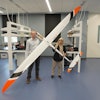Robot Designed to Enforce Social Distancing
Of all the new normals we are working with, let's hope this isn't one of them.
Researchers from the University of Maryland have created the CS-robot, a mobile Covid surveillance robot that detects non-compliance and social distancing breaches.
The autonomous robot locates groups of people and then encourages them to move apart with a message on the screen, like the teacher with the ruler at the dance. The robot can also take thermal images and send them to security and healthcare personnel.
The CS-robot uses an onboard camera and LiDAR sensor to detect breaches. The thermal camera can find people with fevers, potentially helping with contact tracing, and it can tap into closed-circuit television to make it more accurate.
In tests, the robot detected and addressed most of the breaches, but the researchers stressed that they need to refine the technology and see how robots will impact people's behavior in crowds.
DARPA Wants to Make Microorganism Food
In late November, DARPA launched the ReSource program, which is working to develop an integrated system that can convert plastics and other energy-dense waste into food and other chemicals. The program is already in Phase II and has a number of teams actively working on conversion technology.
Last week, DARPA announced Cornucopia, a similar, but much more ambitious program to feed soldiers and civilians.
Military deployments are expensive and logistically challenging. The problem is shipping tons of food to feed troops for months. The same is true for humanitarian and disaster relief efforts. Cargo space is valuable and, if Cornucopia is a success, it could be used for other vital supplies.
The program calls for onsite food production on-demand using air, water and electricity to make nutritious foodstuffs out of microorganisms. Oh, and they want them to taste good and offer complete nutrition with minimal supplementation.
Humans eat microbes every day, and companies have recently shown the ability to create protein-based products from microorganisms. While these commercial technologies are exciting, DARPA needs to produce more than protein, like fats, carbohydrates, and dietary fiber, making palatable foodstuffs with various flavors and textures with mobile infrastructure.
3D Printed Suicide Pod Could be Operational by 2022
Sarco is a unique 3D-printed capsule. It's also a suicide pod. Developed by Philip Nitschke, founder and director of Exit International, the Sarco suicide capsule is a euthanasia capsule activated by the person inside the pod.
Nitschke, also known as Dr. Death, says Sarco is more than 20 years in the making, beginning back when the doc began developing a machine capable of helping a person die. Much of the idea involves letting the person push the button that activates the process.
Last week, the Sarco suicide capsule passed legal review in Switzerland and could be operational as soon as 2022. According to an article from Swiss Info, about 1,300 people died using assisted suicide in Switzerland in 2020. The current method uses liquid sodium pentobarbital. The person ingests it and falls asleep within two to four minutes before falling into a coma and dying. Sarco is designed to make things simpler and swifter.
The Sarco drew inspiration for both its name and design from the sarcophagus. It was designed to be universally understandable. For example, it is clear how to enter.
Upon entering the pod, the person is asked a series of questions before pushing a "die" button that triggers their demise.
Once it's activated, the capsule fills with nitrogen, the person loses consciousness, and the entire process takes about 30 seconds. Death is the result of oxygen and carbon dioxide deprivation.
While it does have a "die" button, it also has an emergency stop and an escape hatch in case the person has a change of heart.
Right now, two Sarco prototypes exist. One is in a German museum, and the other wasn't "aesthetically pleasing," so it was mothballed. The third is currently being 3D printed in the Netherlands. If everything goes well, it could be in Switzerland, where assisted suicide is legal, by next year.






















